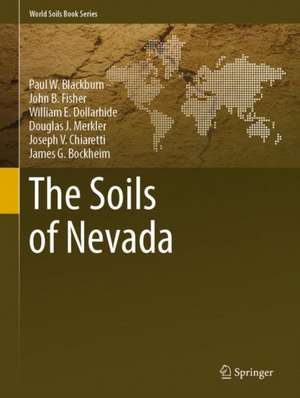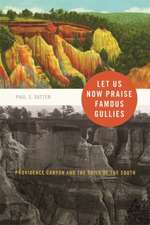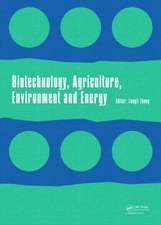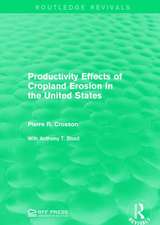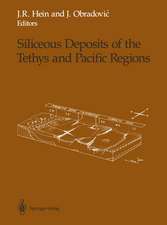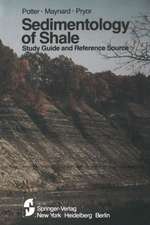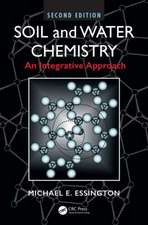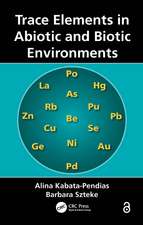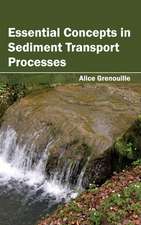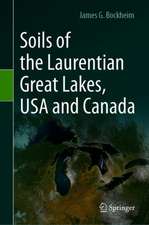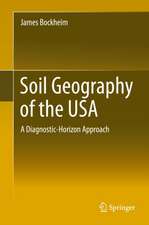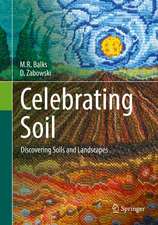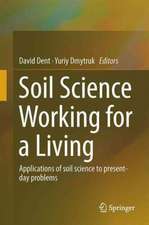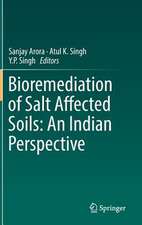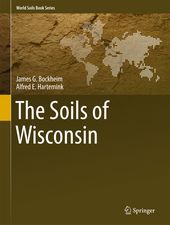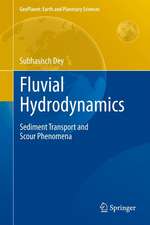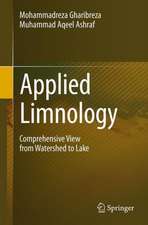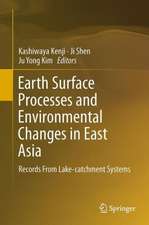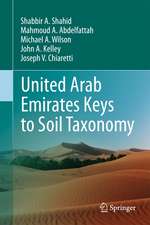The Soils of Nevada: World Soils Book Series
Autor Paul W. Blackburn, John B. Fisher, William E. Dollarhide, Douglas J. Merkler, Joseph V. Chiaretti, James G. Bockheimen Limba Engleză Hardback – 3 oct 2020
With an average mean annual precipitation of 175 mm (7 in), Nevada is the driest state in the USA. More than three-quarters (89%) of the state has been mapped and the first soil survey was completed in 1909. Nevada is divided into 10 major land-resource areas and features two large deserts (the Great Basin Desert and the Mojave Desert), and over 100 north–south trending enclosed basins separated by mountain ranges (Basin and Range Province), several of which have peaks exceeding 3,400 m. Further, the soils of Nevada represent seven of the 12 globally recognized orders, 29 suborders, 69 great groups, and over 1,800 soil series, and some of the classic research on the origin of duripans andpetrocalcic horizons was conducted in the state. This book presents the first report on the soils of Nevada and provides the first soil map of Nevada utilizing soil.
| Toate formatele și edițiile | Preț | Express |
|---|---|---|
| Paperback (1) | 791.71 lei 6-8 săpt. | |
| Springer International Publishing – 4 oct 2021 | 791.71 lei 6-8 săpt. | |
| Hardback (1) | 799.79 lei 3-5 săpt. | |
| Springer International Publishing – 3 oct 2020 | 799.79 lei 3-5 săpt. |
Din seria World Soils Book Series
- 18%
 Preț: 962.81 lei
Preț: 962.81 lei - 18%
 Preț: 1231.01 lei
Preț: 1231.01 lei - 18%
 Preț: 974.98 lei
Preț: 974.98 lei - 18%
 Preț: 791.71 lei
Preț: 791.71 lei - 18%
 Preț: 914.20 lei
Preț: 914.20 lei - 18%
 Preț: 998.97 lei
Preț: 998.97 lei - 18%
 Preț: 978.12 lei
Preț: 978.12 lei - 15%
 Preț: 649.87 lei
Preț: 649.87 lei - 15%
 Preț: 646.62 lei
Preț: 646.62 lei - 18%
 Preț: 739.62 lei
Preț: 739.62 lei - 15%
 Preț: 649.87 lei
Preț: 649.87 lei - 18%
 Preț: 949.23 lei
Preț: 949.23 lei - 15%
 Preț: 642.65 lei
Preț: 642.65 lei - 20%
 Preț: 607.19 lei
Preț: 607.19 lei - 24%
 Preț: 762.77 lei
Preț: 762.77 lei - 24%
 Preț: 1076.16 lei
Preț: 1076.16 lei - 24%
 Preț: 771.02 lei
Preț: 771.02 lei - 20%
 Preț: 579.73 lei
Preț: 579.73 lei - 20%
 Preț: 574.08 lei
Preț: 574.08 lei - 24%
 Preț: 921.13 lei
Preț: 921.13 lei - 20%
 Preț: 609.00 lei
Preț: 609.00 lei - 24%
 Preț: 751.00 lei
Preț: 751.00 lei - 24%
 Preț: 861.56 lei
Preț: 861.56 lei - 24%
 Preț: 966.56 lei
Preț: 966.56 lei - 24%
 Preț: 816.95 lei
Preț: 816.95 lei - 20%
 Preț: 579.73 lei
Preț: 579.73 lei - 24%
 Preț: 602.44 lei
Preț: 602.44 lei - 20%
 Preț: 591.82 lei
Preț: 591.82 lei - 24%
 Preț: 747.89 lei
Preț: 747.89 lei - 18%
 Preț: 907.11 lei
Preț: 907.11 lei - 20%
 Preț: 589.58 lei
Preț: 589.58 lei - 24%
 Preț: 640.77 lei
Preț: 640.77 lei - 24%
 Preț: 813.41 lei
Preț: 813.41 lei - 24%
 Preț: 886.56 lei
Preț: 886.56 lei
Preț: 799.79 lei
Preț vechi: 975.35 lei
-18% Nou
Puncte Express: 1200
Preț estimativ în valută:
153.06€ • 166.20$ • 128.57£
153.06€ • 166.20$ • 128.57£
Carte disponibilă
Livrare economică 01-15 aprilie
Preluare comenzi: 021 569.72.76
Specificații
ISBN-13: 9783030531560
ISBN-10: 3030531562
Pagini: 301
Ilustrații: XV, 301 p. 104 illus., 84 illus. in color.
Dimensiuni: 210 x 279 mm
Greutate: 0.95 kg
Ediția:1st ed. 2021
Editura: Springer International Publishing
Colecția Springer
Seria World Soils Book Series
Locul publicării:Cham, Switzerland
ISBN-10: 3030531562
Pagini: 301
Ilustrații: XV, 301 p. 104 illus., 84 illus. in color.
Dimensiuni: 210 x 279 mm
Greutate: 0.95 kg
Ediția:1st ed. 2021
Editura: Springer International Publishing
Colecția Springer
Seria World Soils Book Series
Locul publicării:Cham, Switzerland
Cuprins
Overview.- History of Soil Studies in Nevada.- Soil-Forming Factors.- General Soil Regions of Nevada.- Soil Geomorphology of Nevada.- Diagnostic Horizons and Taxonomic Structure of Nevada Soils.- Taxonomic Soil Regions of Nevada.- Aridisols.- Mollisols.- Entisols.- Inceptisols.- Alfisols, Vertisols, and Andisols.- Soil-Forming Processes in Nevada.- Benchmark, Endemic, Rare, and Endangered Soils in Nevada.-Land Use in Nevada.- Conclusions.
Notă biografică
Paul W. Blackburn began working as a Soil Scientist for the SCS, later to become the NRCS, in June 1976. Paul retired as an MLRA Project Office Leader in January of 2018 with a total of 41 years of service. Paul is enjoying staying close to home, doing small home remodel projects, and teaching grandsons about soils.
John B. Fisher worked over 41 years as a Soil Scientist in Nevada with NRCS before retiring as a Senior Regional Soil Scientist in 2017. John lives in Reno and enjoys reading, gardening, and playing with his grandsons.
William E. Dollarhide transferred to Nevada NRCS in 1969. He served as a Soil Scientist, Project Leader, Assistant State Soil Scientist, State Soil Scientist, and Major Land Resource leader before retiring in 2010, after 41 years of service. Bill lives in Reno with his family and enjoys gardening and playing senior softball.
Douglas J. Merkler began working as a Soil Scientist for the SCS, laterto become the NRCS, in September 1978. Douglas retired as a Resource Soil Scientist for Nevada in July of 2017, just shy of 39 years of service. Douglas remains active in the Soil Science Society of America and the International Biogeographic Society, is currently teaching at Nevada State College, and has started a resource-oriented, drone-based consulting firm with his wife in retirement.
Joseph V. Chiaretti began his career as a Soil Scientist with the BLM in south-central New Mexico in 1978 and then transferred to the SCS (now NRCS) in 1979. He mapped soils on four soil survey areas in New Mexico over 19 years, serving as lead field mapper and Project Leader. Joe, along with co-authors Paul, John, and Douglas, is recognized by the NRCS as a million-acre mapper for the National Cooperative Soil Survey (NCSS) program. In January 1998, Joe transferred to Nevada and conducted quality assurance on soil survey products in the former Great Basin MLRA region until November 2008. He then served on the Soil Survey Standards staff of the National Soil Survey Center in Lincoln, Nebraska as an instructor, the principal editor of NCSS standards documents such as the National Soil Survey Handbook and the Keys to Soil Taxonomy, and the national soil classification expert. Joe retired from federal service in early 2014 and is now enjoying his hobbies of gardening, hiking, and traveling back in his adopted State of Nevada. James G. Bockheim was Professor of Soil Science at the University of Wisconsin from 1975 until his retirement in 2015. He has conducted soil genesis and geography in many parts of the world. His interest in Nevada stemmed from its high pedodiversity. His previous books include Pedodiversity (2013; with J. J. Ibáñez); Soil Geography of the USA: a Diagnostic-Horizon Approach (2014); Cryopedology (2015); The Soils of Antarctica (2015; editor), and The Soils of Wisconsin (2017; with A. E. Hartemink), and Soils of the Laurentide Great Lakes, USA and Canada.
John B. Fisher worked over 41 years as a Soil Scientist in Nevada with NRCS before retiring as a Senior Regional Soil Scientist in 2017. John lives in Reno and enjoys reading, gardening, and playing with his grandsons.
William E. Dollarhide transferred to Nevada NRCS in 1969. He served as a Soil Scientist, Project Leader, Assistant State Soil Scientist, State Soil Scientist, and Major Land Resource leader before retiring in 2010, after 41 years of service. Bill lives in Reno with his family and enjoys gardening and playing senior softball.
Douglas J. Merkler began working as a Soil Scientist for the SCS, laterto become the NRCS, in September 1978. Douglas retired as a Resource Soil Scientist for Nevada in July of 2017, just shy of 39 years of service. Douglas remains active in the Soil Science Society of America and the International Biogeographic Society, is currently teaching at Nevada State College, and has started a resource-oriented, drone-based consulting firm with his wife in retirement.
Joseph V. Chiaretti began his career as a Soil Scientist with the BLM in south-central New Mexico in 1978 and then transferred to the SCS (now NRCS) in 1979. He mapped soils on four soil survey areas in New Mexico over 19 years, serving as lead field mapper and Project Leader. Joe, along with co-authors Paul, John, and Douglas, is recognized by the NRCS as a million-acre mapper for the National Cooperative Soil Survey (NCSS) program. In January 1998, Joe transferred to Nevada and conducted quality assurance on soil survey products in the former Great Basin MLRA region until November 2008. He then served on the Soil Survey Standards staff of the National Soil Survey Center in Lincoln, Nebraska as an instructor, the principal editor of NCSS standards documents such as the National Soil Survey Handbook and the Keys to Soil Taxonomy, and the national soil classification expert. Joe retired from federal service in early 2014 and is now enjoying his hobbies of gardening, hiking, and traveling back in his adopted State of Nevada. James G. Bockheim was Professor of Soil Science at the University of Wisconsin from 1975 until his retirement in 2015. He has conducted soil genesis and geography in many parts of the world. His interest in Nevada stemmed from its high pedodiversity. His previous books include Pedodiversity (2013; with J. J. Ibáñez); Soil Geography of the USA: a Diagnostic-Horizon Approach (2014); Cryopedology (2015); The Soils of Antarctica (2015; editor), and The Soils of Wisconsin (2017; with A. E. Hartemink), and Soils of the Laurentide Great Lakes, USA and Canada.
Textul de pe ultima copertă
This book discusses Nevada in the context of the history of soil investigations; soil-forming factors; general soil regions; soil geomorphology; taxonomic structure of the soils; taxonomic soil regions; soil-forming processes; benchmark, endemic, rare, and endangered soils; and use of soils.
With an average mean annual precipitation of 175 mm (7 in), Nevada is the driest state in the USA. More than three-quarters (89%) of the state has been mapped and the first soil survey was completed in 1909. Nevada is divided into 10 major land-resource areas and features two large deserts (the Great Basin Desert and the Mojave Desert), and over 100 north–south trending enclosed basins separated by mountain ranges (Basin and Range Province), several of which have peaks exceeding 3,400 m. Further, the soils of Nevada represent seven of the 12 globally recognized orders, 29 suborders, 69 great groups, and over 1,800 soil series, and some of the classic research on the origin of duripans andpetrocalcic horizons was conducted in the state. This book presents the first report on the soils of Nevada and provides the first soil map of Nevada utilizing soil.
With an average mean annual precipitation of 175 mm (7 in), Nevada is the driest state in the USA. More than three-quarters (89%) of the state has been mapped and the first soil survey was completed in 1909. Nevada is divided into 10 major land-resource areas and features two large deserts (the Great Basin Desert and the Mojave Desert), and over 100 north–south trending enclosed basins separated by mountain ranges (Basin and Range Province), several of which have peaks exceeding 3,400 m. Further, the soils of Nevada represent seven of the 12 globally recognized orders, 29 suborders, 69 great groups, and over 1,800 soil series, and some of the classic research on the origin of duripans andpetrocalcic horizons was conducted in the state. This book presents the first report on the soils of Nevada and provides the first soil map of Nevada utilizing soil.
Caracteristici
Presents the only comprehensive summary of Nevada’s natural resources (85% of is Nevada federally managed) Includes abundant (70) color illustrations, making it attractive for instruction at the high-school level and above Provides a valuable addition to the World Soil Book Series state-level collection Written by leading experts with over 200 years of collective experience in all areas of soil science and allied disciplines
